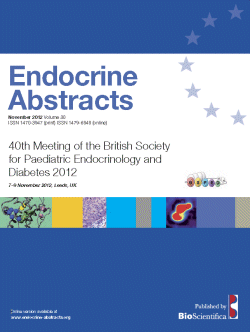
40th Meeting of the British Society for Paediatric Endocrinology and Diabetes
Oral Communications
Oral Communications 2
ea0030oc2.1 | Oral Communications 2 | BSPED2012
Assessment of adrenal function in female to male adolescents with gender identity dysphoria
Ajzensztejn Michal , Gopalakrishnamoorthy Mahalakshmi , Dawnay Anne , Viner Russell , Brain Caroline , Butler Gary
ea0030oc2.2 | Oral Communications 2 | BSPED2012
Deficiency of the triple A syndrome gene product, ALADIN, renders human adrenal cells susceptible to oxidative stress with subsequent impact on steroidogenesis
Prasad Rathi , Clark Adrian , Storr Helen
ea0030oc2.3 | Oral Communications 2 | BSPED2012
Does vitamin D modulate mitochondrial oxidative phosphorylation?
Sinha Akash , Ball Steve , Hollingsworth Kieren , Cheetham Tim
ea0030oc2.4 | Oral Communications 2 | BSPED2012
Prenatal dexamethasone for treatment of congenital adrenal hyperplasia: a possible association with late gestational fetal demise in two cases
Peacock Amanda , Abbey Ianthe , Alvi Sabah , Bennett Chris , Dwyer James , Glanville Tracey , Mushtaq Talat
ea0030oc2.5 | Oral Communications 2 | BSPED2012
Abnormal neurological and developmental outcomes in children with persistent and spontaneously resolving congenital hyperinsulinism
Avatapalle Bindu , Shah Sajni , Pryce Megan , Nicholson Jacqueline , Rigby Lindsey , Caine Louise , Didi Mohammed , Ehtisham Sarah , Patel Leena , Skae Mars , Padidela Raja , Banerjee Indraneel , Clayton Peter
ea0030oc2.6 | Oral Communications 2 | BSPED2012
Childhood body composition is associated with maternal plasma polyunsaturated fatty acids status in late pregnancy
Moon Rebecca J , Harvey Nicholas C , Ntani Georgia , Davies Justin H , Inskip Hazel M , Godfrey Keith , Dennison Elaine M , Calder Philip , Cooper Cyrus
ea0030oc2.7 | Oral Communications 2 | BSPED2012
Growth, GH–IGF1 status and response to r-hGH therapy in 3-M syndrome, related to mutation status
Sakhinia Faezeh , Hanson Dan , Murray Philip , Kirk Jeremy , Cole Trevor , Skae Mars , Banerjee Indi , Padidela Raja , Patel Leena , Clayton Peter
ea0030oc2.8 | Oral Communications 2 | BSPED2012
Genetic screening in a large cohort of patients with congenital hypopituitarism; current knowledge and future directions
Alatzoglou Kyriaki S , Turton James P G , Kelberman Daniel , McCabe Marc J , Gregory Louise C , Webb Emma A , McNay David E G , Woods Kathryn S , Mehta Ameeta , Dattani Mehul T
ea0030oc2.9 | Oral Communications 2 | BSPED2012
GH neuro-secretory dysfunction following traumatic brain injury in childhood
Daskas Nikolaos , Sharples Peta , Crowne Elizabeth
ea0030oc2.10 | Oral Communications 2 | BSPED2012
When is it justifiable to await venous thyroid function tests before starting thyroxine treatment in infants referred with capillary TSH elevation?
Pokrovska Tzveta , Jones Jeremy , Shaikh Guftar , Donaldson Malcolm



